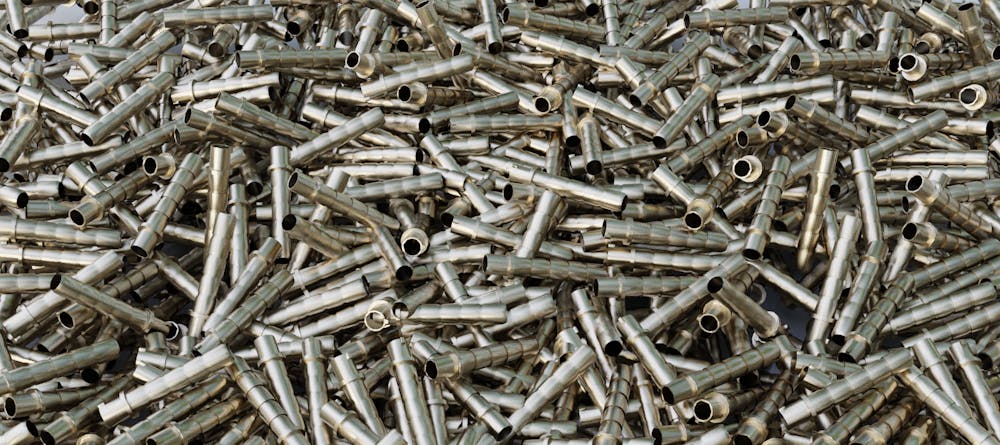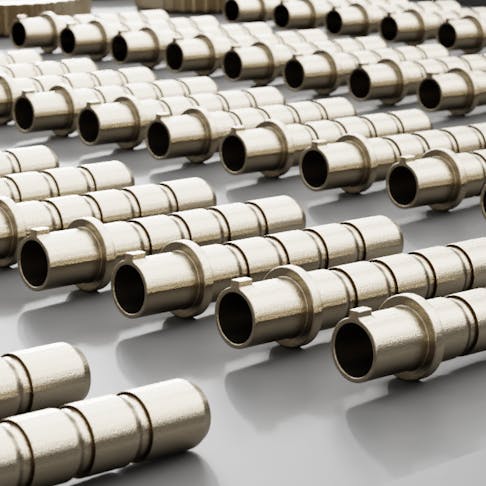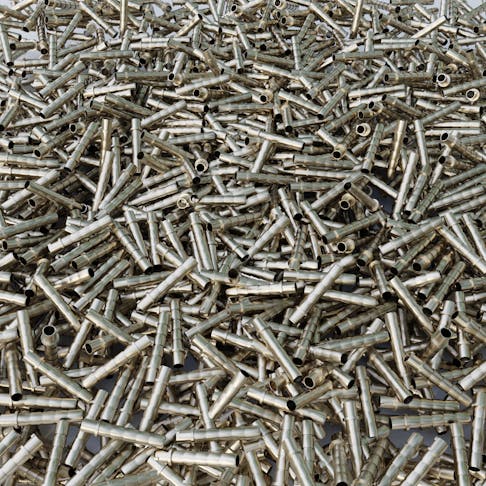Metal Injection Molding Service
Get Complex Small-Sized Metal Parts in High Volume With Xometry. Subject to availability. Xometry doesn't guarantee that we can provide this service at any given time.

What is MIM (Metal Injection Molding)?
Metal injection molding (MIM) is a multi-stage manufacturing process used to produce smaller, complex metal parts in high quantities. Polymerized metal powders are injected into molds, de-binded, and sintered, which allows for the production of accurate parts in a range of materials.
Xometry employs industry experts who have first-hand experience with the MIM process and work closely with our manufacturing partners to deliver high-quality parts to our customers! Xometry also offers other various high-volume metal manufacturing processes such as die casting and extrusion. You can learn more about metal injection molding vs die casting in our article on the subject. You can also check out our plastic injection molding capabilities.
The Metal Injection Molding Process
MIM begins with a polymerized metal feedstock containing tiny metal particles with a plastic binder injected into a mold cavity. After molding, the parts release, and the runners get trimmed. The resulting parts are considered "green parts" at this point. The parts go through a de-binding process, removing the polymers in the part, resulting in porous metal "brown parts." Lastly, the parts are heated to high temperatures in a furnace to sinter the metal particles, resulting in a non-porous, almost fully dense part. Some shrinkage occurs during the sintering process as the metal particles fuse together.
Metal Injection Molding Advantages and Disadvantages
Metal molding has some distinct advantages compared to other manufacturing processes. Some of them include:
- Complex Shapes: Can produce metal injection molded parts with intricate details, thin walls, sharp internal corners, undercuts, and more, all within a single operation.
- Reduction of Assemblies: Combining what would typically require multiple parts made from other processes into a single component is possible with the MIM process. Consolidating the design simplifies your assemblies and reduces cost.
- Accuracy: Critical tolerances can be achieved with highly repeatable results. Parts can be post-machined for extra tight dimensions and features.
- High-Performance Materials: Get tough, high-performance parts made using materials such as stainless steel. MIM is best suited for high melting temperature materials versus softer materials such as aluminum or zinc that are a better fit for die casting.
- Cost and Speed: Ideal for optimizing production run cost with return on investment for high volumes and rapid production of small, complex parts.
- Broad Industry Support: Due to the ability to mass-produce parts from biocompatible and hardened materials, MIM is used in medical, firearms, aerospace, and other industries.
However, there are some situations where other processes will be a better fit:
- Short Lead Times for New Parts: Each new part requires one or more new molds, which take time to create. 3D printing has faster lead times for new parts that you need quickly.
- Prototypes or Small Production Runs: For smaller runs, the price per part will be more expensive. Processes including 3D printing or sheet metal production may work better here.
- Large Parts: Parts weighing more than 100 grams or that are more than a few inches across are more difficult to produce, so those will be more expensive.
Metal Injection Molding Materials and Powders
| Alloy Group | Specific Alloys | Description |
|---|---|---|
Alloy Group Stainless Steel | Specific Alloys 316, 316L, 17-4 PH, 303, 304, 440C, and 420P | Description Steel alloys containing high chromium and nickel content which provide superior corrosion and heat resistance. They are commonly used in the medical industry for equipment such as surgical tools. |
Alloy Group Low-Alloy Steel | Specific Alloys Fe-Ni (Iron-Nickle), FN02, FN08, 4140, 8620, and 100Cr6 | Description A steel alloy containing a lower content of other alloys to enhance performance and mechanical properties over carbon steels. Cost-effective and highly machinable. |
Alloy Group Tool Steel | Specific Alloys M2 | Description Carbon or alloy steel that undergoes strict quality procedures to assure the given grade will perform a specific task. High hardness and abrasion resistance properties make them ideal for tooling and mold-making purposes. |
Alloy Group Soft Magnetic Steel | Specific Alloys Fe-Ni50, Fe3Si, FeCo50, and FeCoV | Description Steel alloys characterized by high magnetic permeability. They can easily be magnetized and demagnetized, making them highly suited for electric and electromagnetic applications such as solenoids, relays, and fuel injectors. |
Alloy Group Tungsten Heavy Alloy | Specific Alloys W-Ni-Fe (Tungsten Nickel Iron) and W-Ni-Cu (Tungsten Nickel Copper) | Description A metal alloy with high tungsten content and a small number of other metals. They are often used for radiation shielding and weights due to the high-density property of tungsten. |
Alloy Group WC-Co Cemented Carbide | Specific Alloys WC-Co (Tungsten carbide-cobalt) | Description An alloy of ceramic tungsten carbide and cobalt. Cobalt particles are embedded in a tungsten carbide matrix which makes up the material. Due to its high hardness and wear resistance properties, it is mainly used in mining tools, cutters, wear-resistant machine parts, and surgical instruments. |
Additional materials may be available upon request! Tell us about your custom requirements here!
Our Common Finishes for MIM Parts
As-Sintered
With no secondary processing, parts will typically appear matte and maintain an average surface roughness between 16µin - 32µin Ra. Gate marks, parting lines, or ejector pin marks may be visible.
Electropolishing
An electrochemical process is used to remove material from the surface, improving the surface finish. Commonly used to polish, passivate and deburr parts. Will not remove parting lines or ejector pin marks.
Passivation
Parts are given a chemical treatment, typically in nitric or citric acid, which removes free iron from the surface. This process creates a protective oxide layer on the surface which helps prevent corrosion.
Metal Plating
All metallic platings applicable to wrought material counterparts are available. Xometry's plating options include electroless nickle, zinc, tin, silver, gold, and more.
Anodizing (Type II or Type III)
* Available for nonferrous metals such as aluminum and titanium.
Type II anodizing creates a corrosion-resistant oxide finish. Parts can be anodized in different colors—clear, black, red, and gold are the most common. Type III (Hardcoat) is a thicker finish and creates a wear-resistant layer in addition to the corrosion resistance seen with Type II. Anodized coatings are not electrically conductive.
Chemical Film
A chromate conversion coat can be applied to protect aluminum and magnesium from corrosion and improve the adhesion of paints and primers. Chemical film conversion coatings are electrically conductive.
Media Tumbling
Parts are subjected to vibratory media tumbling to smooth surfaces. Parting lines or ejector pin marks may still be visible.
Heat Treatment
Parts will be in an annealed condition after sintering. Our heat treatment options include carburization, induction hardening, nitriding, etc.
Custom
Don't see the finish you need? Let us know and will look into accommodating other finishing processes to meet your requirements!

Have an upcoming metal injection molding project?
Applications of Metal Injection Molding


Example devices include one-time use instruments, surgical tools, scalpel handles, and implants.

Components such as triggers and levers are commonly produced via MIM.

Consumer applications include watch cases, connectors for electronics, and laptop hinges.
Frequently Asked Questions About MIM
What tolerances can the MIM process achieve?
As-sintered tolerances typically range from ±0.3%-0.5% of the dimension. The tolerance capability is mainly dependent on multiple variables, including part geometry, material, mold construction, etc.
Xometry's MIM manufacturers can incorporate secondary machining operations after sintering to achieve tolerances tighter than the typical tolerances the process can produce. Parts designed specifically for the MIM process are ideal for cost and time savings, as secondary operations can significantly affect these factors.
What are the restrictions or limitations of metal injection molding?
The most common limiting factor with MIM is part size. Due to mold limitations and economics, MIM is typically best suited for parts that weigh less than 100 grams and can fit in the palm of your hand.
Part quantity can also be a limitation. To take advantage of the potential cost savings compared to other processes, you will generally need to order a high quantity of parts to offset upfront tooling costs with MIM.
Can I use metal injection molding to prototype designs?
MIM is optimal for high-volume production and not suitable for prototyping. However, Xometry offers many other processes, such as direct metal laser sintering (DMLS) or metal binder jetting, which are excellent options for prototyping metal parts!
What is the density of metal injection molded parts?
Final parts typically fall in a density range of 96%-99% and will be water-tight.
Do parts shrink during the process?
Parts will shrink roughly 20% from the molded state to the post-sintered state. The shrink factor is usually accounted for during mold creation by the manufacturer, so your designed dimensions should reflect your final part requirements.
What type of parts are good candidates for the metal injection molding process?
Generally speaking, parts with higher complexity, lots of dimensions, small in size (~100g or less), and quantities that would be cost-prohibitive to produce in other manufacturing processes are good criteria for MIM consideration. MIM is also excellent for consolidating designs that usually require assembly and instead be made as one component. Our industry experts will be happy to work with you to help you determine if MIM is right for you!
Why Choose Xometry for Metal Injection Molding?

Endless Options
Choose from millions of possible combinations of materials, finishes, tolerances, markings, and certifications for your order.

Expert Project Management
With experts in medical, automotive, aerospace, and more, our experts are here to provide robust support. We handle the hassle of sourcing, project management, logistics, and shipping.

Vetted Network
We are ISO 9001:2015, ISO 13485:2016, and AS9100D certified. Only the top shops that apply to become suppliers make it through our qualification process.